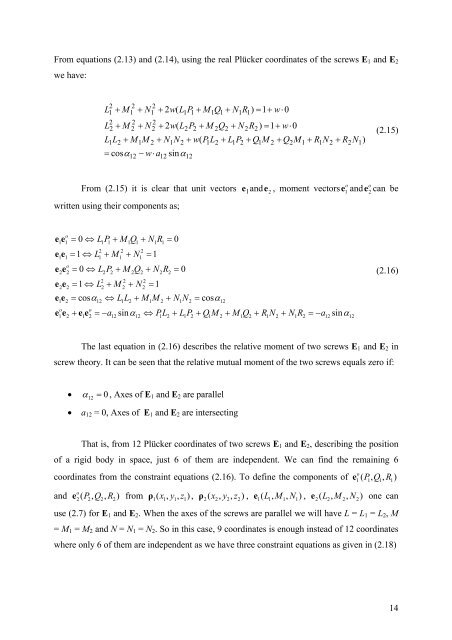Kinematic and Dynamic Analysis of Spatial Six Degree of Freedom ...
Kinematic and Dynamic Analysis of Spatial Six Degree of Freedom ...
Kinematic and Dynamic Analysis of Spatial Six Degree of Freedom ...
Create successful ePaper yourself
Turn your PDF publications into a flip-book with our unique Google optimized e-Paper software.
From equations (2.13) <strong>and</strong> (2.14), using the real Plücker coordinates <strong>of</strong> the screws E1 <strong>and</strong> E2<br />
we have:<br />
L<br />
L<br />
2<br />
1<br />
2<br />
2<br />
L L<br />
1<br />
+ M<br />
+ M<br />
2<br />
2<br />
1<br />
2<br />
2<br />
+ M<br />
12<br />
+ N<br />
+ N<br />
1<br />
M<br />
2<br />
1<br />
2<br />
2<br />
2<br />
= cosα<br />
− w⋅<br />
a<br />
+ 2w(<br />
L P + M Q + N R ) = 1+<br />
w⋅<br />
0<br />
+ N<br />
12<br />
1<br />
N<br />
2<br />
1<br />
2<br />
sinα<br />
1<br />
+ 2w(<br />
L P + M Q<br />
12<br />
2<br />
1<br />
1<br />
2<br />
+ w(<br />
P L<br />
2<br />
1<br />
2<br />
1<br />
1<br />
+ N<br />
2<br />
2<br />
1<br />
2<br />
+ L P + Q M<br />
From (2.15) it is clear that unit vectors e1<strong>and</strong> 2<br />
written using their components as;<br />
e e = 0 ⇔ L P + M Q + N R = 0<br />
o<br />
1 1<br />
e e = 1 ⇔ L + M<br />
1<br />
o<br />
2 2<br />
2<br />
1<br />
o<br />
1<br />
1<br />
e e<br />
2<br />
2<br />
e e<br />
2<br />
o<br />
1 2<br />
2<br />
1<br />
12<br />
1<br />
= 1 ⇔ L<br />
+ e e<br />
2<br />
2<br />
2<br />
1<br />
2<br />
12<br />
2<br />
1<br />
+ M<br />
2<br />
2<br />
1<br />
1<br />
2<br />
2<br />
1<br />
+ N<br />
e e = 0 ⇔ L P + M Q<br />
12<br />
2<br />
1<br />
2<br />
+ N<br />
2<br />
2<br />
1<br />
1<br />
= 1<br />
+ N<br />
2<br />
= 1<br />
2<br />
1<br />
1<br />
R<br />
2<br />
2<br />
= 0<br />
e e = cosα<br />
⇔ L L + M M + N N = cosα<br />
1<br />
1<br />
2<br />
2<br />
1<br />
12<br />
2<br />
1<br />
R ) = 1+<br />
w⋅<br />
0<br />
2<br />
1<br />
2<br />
+ Q<br />
2<br />
M<br />
1<br />
+ R N<br />
1<br />
2<br />
+ R<br />
2<br />
N<br />
1<br />
)<br />
(2.15)<br />
e , moment vectors o<br />
e <strong>and</strong> o<br />
e can be<br />
= −a<br />
sinα<br />
⇔ PL<br />
+ L P + Q M + M Q + R N + N R = −a<br />
sinα<br />
The last equation in (2.16) describes the relative moment <strong>of</strong> two screws E1 <strong>and</strong> E2 in<br />
screw theory. It can be seen that the relative mutual moment <strong>of</strong> the two screws equals zero if:<br />
• 12 0 = α , Axes <strong>of</strong> E1 <strong>and</strong> E2 are parallel<br />
• a12 = 0, Axes <strong>of</strong> E1 <strong>and</strong> E2 are intersecting<br />
That is, from 12 Plücker coordinates <strong>of</strong> two screws E1 <strong>and</strong> E2, describing the position<br />
<strong>of</strong> a rigid body in space, just 6 <strong>of</strong> them are independent. We can find the remaining 6<br />
o<br />
coordinates from the constraint equations (2.16). To define the components <strong>of</strong> e P,<br />
Q , R )<br />
1<br />
2<br />
1<br />
2<br />
12<br />
1<br />
12<br />
2<br />
1 ( 1 1 1<br />
o<br />
<strong>and</strong> e P , Q , R ) from ρ x , y , z ) , ρ x , y , z ) , e L , M , N ) , e L , M , N ) one can<br />
2(<br />
2 2 2<br />
1(<br />
1 1 1<br />
2(<br />
2 2 2<br />
1(<br />
1 1 1<br />
2(<br />
2 2 2<br />
(2.16)<br />
use (2.7) for E1 <strong>and</strong> E2. When the axes <strong>of</strong> the screws are parallel we will have L = L1 = L2, M<br />
= M1 = M2 <strong>and</strong> N = N1 = N2. So in this case, 9 coordinates is enough instead <strong>of</strong> 12 coordinates<br />
where only 6 <strong>of</strong> them are independent as we have three constraint equations as given in (2.18)<br />
14
















